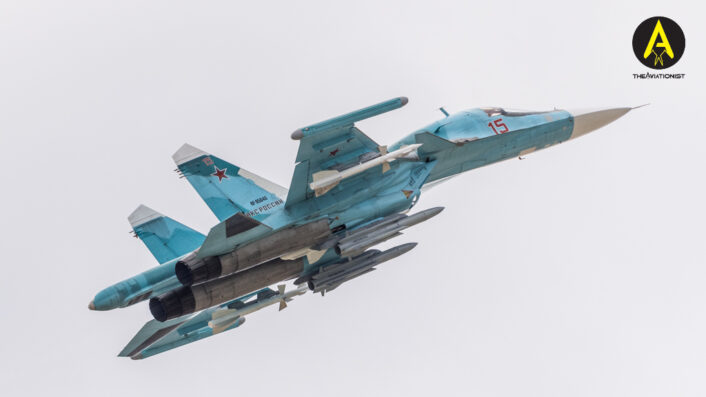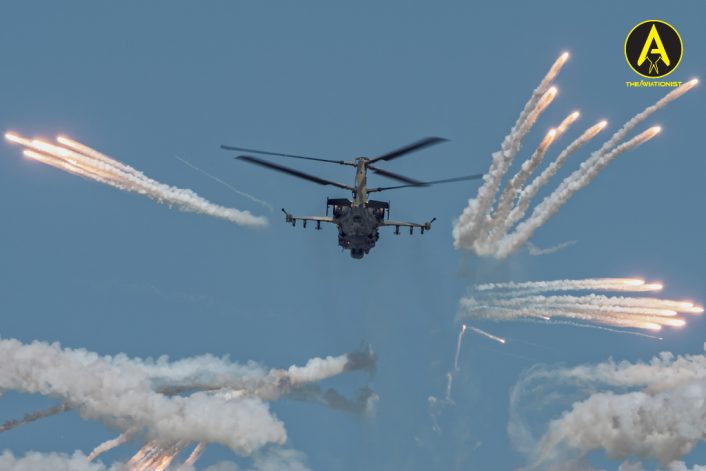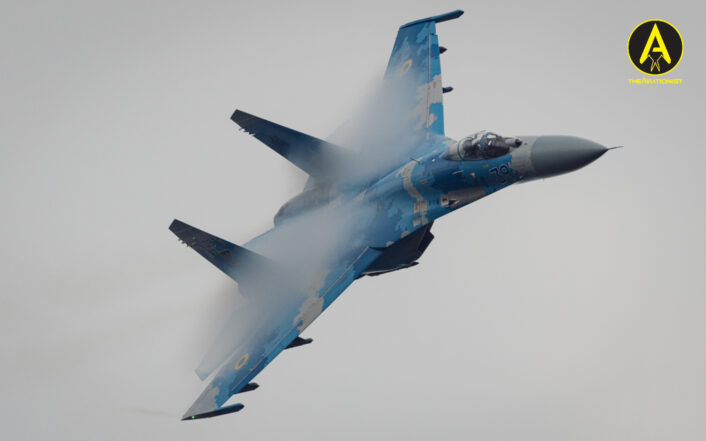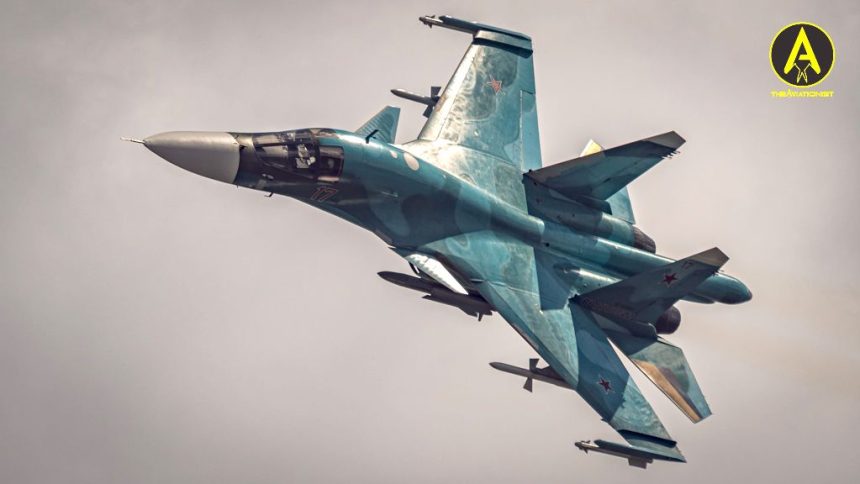Assessing the Air War over Ukraine and Russia’s Air Power today.
Guy Plopsky is a freelance defense analyst specializing in air power and Russian military affairs. During a long conversation with The Aviationist, Plopsky shared his thoughts concerning the Russian air campaign in Ukraine, and discussed with us what could be deduced from what we have seen so far.
Note: since the conflict is quite volatile, this interview depicts the state of knowledge as of Mar. 3, 2022.
The Aviationist: As for the start of the air campaign – it began with missiles. There has been, however, a limited amount of those. Could Russia be saving the assets for later/bigger war? Is that just the tip of the iceberg?
Guy Plopsky: For a military operation of this scale, Russia’s use of missiles has thus far indeed been relatively limited. The latest reported Pentagon’s estimate (March 3) of the total number of missiles of various types launched by the Russians since the beginning of the operation is over 480, approximately 100 of which were launched during the opening phase. While this is an unprecedented quantity for the Russian military, it’s certainly no “Shock and Awe.” To put it into perspective, during Operation Iraqi Freedom, the US Navy launched some 320 Tomahawk cruise missiles on the night of March 21, 2003. While the actual number of Russian missiles launched is likely higher that the Pentagon’s estimate – perhaps considerably, – it is still quite limited given that Russia is using missiles against many targets, some of which are big area targets such as airfields/bases that have a large number of potential aimpoints. And, yes – one likely reason for the relatively limited amount of missiles employed is the probable desire not to deplete their stockpiles – there are no reliable estimates of Russian missile stockpiles, but many missiles are believed to be available in relatively limited numbers.
You’ve mentioned the limited stockpile. Actually – we have seen it in the Middle East recently, that you need a large number of missiles to disable an area target, right?
It depends on a lot of factors, but, if you look at Russian targeting of Ukrainian airfields/bases, not only did they appear to go only after a small number of aimpoints/targets on these bases, but some of their strikes were also inaccurate. Also, interestingly, though some of the targets they chose to attack are of high value – operational aircraft, radars, fuel and munitions storage facilities, runways, etc., – others are not. For example, they’ve hit open storage areas for non-operational aircraft.
So you have a combination of a relatively limited number of missiles launched, some wasted on targets that are of little value, plus some that miss, and of course – in such circumstances, you don’t achieve the desired effect. Indeed, while video footage, photographs and satellite imagery confirm the destruction of some operational aircraft, radars and air base facilities, the Ukrainian Air Force, which is relatively small, was not put out of action very early on in the war. The Russians appear to have been slow to carry out subsequent attacks, and, when they did, the results were mixed.
These closely parked MiG-29 Fulcrum are considered none-operational airframes, stored for years and with some potentially unflown for decadeshttps://t.co/oG0BT6C0He
— Joseph Dempsey (@JosephHDempsey) February 28, 2022
Basically they’re verifying the effects following the strike?
Yes, but they did not seem to do so in a timely manner, which points to serious weaknesses in their battle damage assessment capability. Also, as I mentioned before, some of the targets the Russians hit on Ukrainian airbases were of little value, so this also points to a possible lack of accurate and timely intelligence. The Russians have shown that, in a contested environment, they can shoot far, but not see far.
Why is it, do you think, that the initial reports concerning the war were focused on the land invasion? We did not really see a lot of tactical aviation assets involved. I am asking because ever since the Desert Storm, air superiority/supremacy, has been considered to be a must for any military operation? 7 days in (at the time when this interview is done), still no air superiority. What do you think is the cause here?
You’re also absolutely right; the Russians also consider air superiority/supremacy to be very important. Russian military theorists have drawn many lessons from Desert Storm and subsequent US and allied operations. They think that the course and outcome of the struggle in the air/space domain has a cardinal impact on the course and outcome of conflicts and wars as a whole. They therefore regard the establishment of air superiority/supremacy, as very important. So it’s quite puzzling to see the Russians apparently make such limited use of their operational-tactical aviation early on, especially when considering the large number of operational-tactical aviation assets Russia has deployed within range of Ukraine. Indeed, until very recently, the use of operational-tactical aviation appears to have been very limited for a military operation of this scale. Of course, there is likely a lot more that went on that we don’t know about because it hasn’t been captured on film, but footage of Russian tactical aircraft attacking targets has been very sporadic. Only recently have we begun seeing more footage documenting their use. The Russians did not appear to exploit the partial success of their initial missile strikes and follow them up with large fixed-wing strike packages. One explanation is that the Russians probably overestimated their own capabilities and underestimated the Ukrainians. They may have believed that their ground forces would be able to seize key objectives swiftly, and that the extensive use of operational-tactical aviation would therefore not be necessary. This is supported by the fact that the opening phase of missile-aviation and artillery attacks that preceded the ground offensive was quite short. Many analysts expected it to be much longer and more intense. The apparent subsequent reluctance to commit large numbers of tactical aircraft may have been due to possible fears of suffering excessive losses, but, with Ukraine’s air defense capabilities increasingly degraded and with Russia committing more forces, there is now, as I noted earlier, increased operational-tactical aviation activity.
What about the Russian SEAD/DEAD? Was it a relevant part of this operation, or not yet? Or is it the fog of war, and the Ukrainians not sharing information within that scope, regarding their losses of the air defense assets? did the Russians meet a lot of resistance, in the SEAD domain?
Russia is conducting DEAD (destruction of enemy air defense) as part of its broader OCA (offensive counter air) effort. This effort includes targeting airfields/bases, C2 assets, air defense systems, early warning radars, other surface targets, and aircraft in the air. Russia appears to have targeted Ukrainian air defenses primarily using quasi-ballistic and cruise missiles as well as some anti-radiation missiles. The exact extent to which Russia’s DEAD effort has been successful is not entirely clear, but some Ukrainian air defense systems remain operational. Ukrainian air defense systems are mobile, making it more difficult for Russian aviation to locate and destroy them. Indeed, generally speaking, dynamic targeting, particularly against time-sensitive targets in a contested environment, remains a big point of weakness for the VKS (Russian Aerospace Force).
Doctrine-wise, the sophistication levels are nowhere near what we see in the West, aren’t they?
That’s correct. Notably, Russian operational-tactical aviation trains to target air defenses chiefly with unguided weapons, and some of the tactics they employ are of dubious value, potentially resulting in heavy losses if relied upon in actual combat. Moreover, based on what we can glean from Russian Defense Ministry press releases, their exercises appear to exhibit little in the way complex scenarios involving SEAD packages supporting strike packages. On this note, while Russia’s operational-tactical aviation includes many aircraft types capable of employing anti-radiation missiles, it lacks a dedicated SEAD platform. There are no Russian “Wild Weasels.”
How about tactical recce?
The VKS does have tactical recce capabilities, but so far there is no information at all on their employment during the war. As for exercises, the VKS does incorporate tactical recce capabilities in exercises; however, at least based on what we can glean from Russian Defense Ministry press releases, these exercises are not particularly complex and the tactics employed aren’t necessarily suitable for contested environments.
So, there’s no Russian Red Flag counterpart?
No.
Do you think it is possible that the Ukrainian AF uses dispersion methods and highway strips, hence the limited amount of aircraft losses that we’ve seen – despite the numerous strikes against the airbases? The Ukrainian Air Force remains pretty active, given the scale of the initial strikes. As far as I recall, one or two years ago there was this picture of a Su-27 that hit a road sign. Do you think that these tactics are currently being employed?
I remember that incident. The Ukrainian Air Force has been known to conduct such training in the past, but whether they have been able to employ it during the war is not known. As for losses, the Ukrainian Air Force no doubt suffered heavy losses, and it’s not clear exactly how many Ukrainian aircraft are still operational. At least until quite recently, the Ukrainian Air Force is known to have been active – the most famous example of this being Bayraktar TB2 UCAV strike footage. Also, both the Ukrainian Defense Ministry and other sources have been saying that the Ukrainian Air Force is still flying sorties.
We know that in the western military, personnel like JTACs is tasked with coordinating ground support. Does the Russian military use any equivalent personnel, in Spetsnaz for instance?
The Russians use FACs (forward air controllers). Their kit is heavy and leaves much to be desired (communications and target acquisition-wise). The Russians have tested out more modern equipment in Syria, but it is still in the process of being introduced and methods of its employment have yet to be fully developed.
How good is coordination between Russian air assets and air defenses?
Historically, coordination between Russian air and air defenses has been poor, especially with air defenses fielded by the Ground Forces. Issues with coordination date back to Soviet times. For example, during strategic and operational exercises in the 80s and in 1990, it was typical for air defenses to “fire” on 20-30% of friendly aircraft. During the 2008 war with Georgia, a total of 3-4 of the 6 Russian aircraft lost were downed by friendly fire (Russian forces and Ossetian separatists). To this day, joint training between the VKS and Russian Ground Forces air defenses remains very limited.

We know that VKS has numerous CAS assets amassed in the area, still, little CAS sorties are flown. Is the Russian Air Force afraid of Ukrainian, or even worse, own air defenses? As you said, it’s not really uncommon for them to experience blue-on-blue, friendly fire incidents in the past.
It may be a contributing factor, especially given Russia’s more limited IFF capabilities and the limited joint training between the VKS and Ground Forces air defenses; however, Ukrainian air defenses are likely a bigger concern. Like the Russians, Ukrainian forces field a large number of MANPADS, which pose a serious threat to Russian aircraft operating at lower altitudes. Even if Russia successfully destroys Ukraine’s mobile air defense systems, MANPADS will remain a threat. That said, unlike Russian tactical aircraft, Russian helicopters have been far more active, so this once again goes back to the puzzling case of why the former have apparently seen very limited use until recently.
Fullbacks in Ukraine. What gets me here, is the low level flying. That means that the Russians have not finalized the SEAD/DEAD portion of their operation, and they do not feel confident flying high. And a jet that low is a sitting duck for a MANPADS https://t.co/xPfz6ULJxx
— Jacek Siminski (@JacekSiminskiAV) February 28, 2022
I’ve seen footage of two Fullbacks, flying low-level –they are a sitting duck for a MANPADS.
The Su-34 was likely flying low to avoid detection by radar. MANPADS may have been deemed less of a concern in this case.
Why was it decided to conduct very risky airborne operations, or drops, as it was known that no air supremacy was achieved, and as the dropzones were located quite far from the land assets – thus, those operations were doomed since the very beginning?
The heliborne assault on Antonov Airport early in the war was indeed extremely risky, especially given the lack of air supremacy. The move was likely prompted by Russia’s overestimation of its own capabilities – they likely believed that ground forces would reach the area soon enough.

I’m also referring to the reports of the Il-76s being shot down.
Despite numerous reports, I have not come across any evidence (video footage, photos, etc.) to suggest this is true. Without even minimal evidence to suggest these reports are true, it’s impossible to say for sure.
Why the Russian air defenses seem to be sleeping – there was some footage of a column of vehicles, where the Pantsir system had no radar deployed. Do you think this is laziness, or the lack of training?
Pantsirs do train to escort convoys, so this is another one of the many puzzling things we’ve observed during this operation. One possible reason is that Russian air defense crews have a lot of confidence that they will not face an attack from the air because they may have been told that Russia has air supremacy, and may have believed that Russian fighters will deal with aerial threats. As a result, they may have been less careful. This relates to the general lack of professionalism that is apparent in this Russian military operation. Coordination between forces in this operation appears to often be poor. There are issues with logistics, and some equipment is seemingly being abandoned, including air defense systems.
Why is it that the Russian land forces seem to ignore the threat posed by the Ukrainian drones and aviation – with the columns being tight, and movement done during daytime, not at night?
One possible reason, and this is related to the previous question, is that maybe Russian troops believe they have air supremacy and let their guard down, not expecting an attack from the air and believing that the Ukrainian Air Force was wiped out or that, even if it wasn’t, their own air defenses and fighter aircraft would effectively protect them. Regardless, this is highly unprofessional. Apart from the Pantsir which you mentioned – which is a VKS-operated system – the Russian Ground Forces have many of their own air defense systems in Ukraine. Yet, the presence of Russian air defense systems did not completely prevent air attacks on Russian forces. Not only did Ukrainian aircraft manage to get airborne, they also managed to carry out attacks on Russian forces. This shows that not only did Russian OCA efforts against surface targets have mixed results, but that Russian forces didn’t conduct proper fighter sweeps and DCA (defensive counter air) either. Notably, Russia failed to destroy Ukraine’s TB2 UCAVs on the ground in a timely manner, allowing Ukraine to employ them. Once in the air, the TB2 is much more difficult to detect than Ukraine’s manned aircraft.

So this is an interesting point – it’s beyond their cognition that anything could happen, right?
It’s hard to say. The Russians are well aware of the threat posed by UAVs and the need to counter them. Their military journals are filled with articles on this and related topics. That said, there has always been a large gap between theory and practice in the Russian military, even though Russian air defenses do train to intercept UAVs.
The Nagorno-Karabakh conflict should be a painful lesson here, right?
Yes, this is a conflict they paid very close attention to. They also paid very close attention to their own experience in Syria, where Khmeimim air base was subject to drone attacks.
If, and let’s hope this does not happen, ever, Putin was to carry out a limited nuclear strike, or any nuclear strike, what method would be – in your opinion – used to deliver the payload to the theater?
I think if it comes to that – HYPOTHETICALLY – Russia would first launch a tactical nuclear strike. In my opinion they would use the Iskander system for that since Ukraine’s S-300PS system would not be able to intercept its quasi-ballistic missile.
Can one identify any gaps in the training curriculum that were shown through the air campaign thus far?
What I mentioned earlier about the lack of timely battle damage assessment and about SEAD/DEAD training likely applies here. Beyond that, because there is so little footage and information available, especially on actions of Russia’s operational-tactical aviation, it’s really hard to draw conclusions. So I will just briefly note that two things you see Russian helicopters and tactical aircraft perform during the war that they train to do in exercises is fly low and use flares as necessary.










